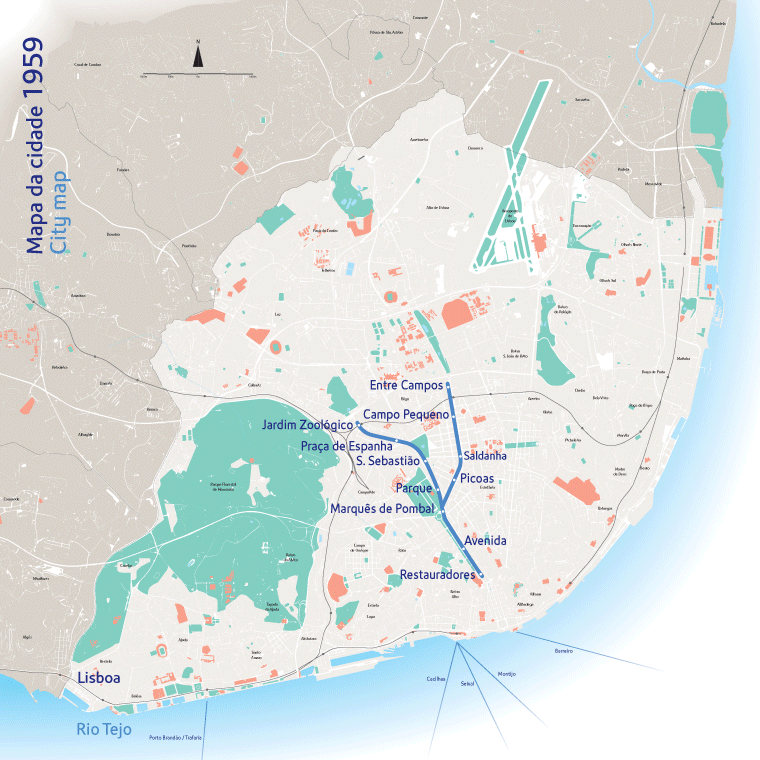
A brief history
Metropolitano de Lisboa was incorporated in January 26, 1948; its corporate is the technical and economic study on an exclusive basis of Lisbon’s collective underground transportation system. The concession for the installation and operation of respective public service was granted in July 1, 1949.
Construction works started in August 7, 1955 and four years later, in December 29, 1959, the new transport system was inaugurated. The new metro network consisted of a Y-shaped line, made up of two distinct stretches: Sete Rios (currently, Jardim Zoológico) – Rotunda (currently, Marquês de Pombal) and Entre Campos – Rotunda (Marquês de Pombal), converging into a common stretch – Rotunda (Marquês de Pombal) – Restauradores.
Metropolitano de Lisboa played a crucial role in the development of the city, drawing the lines of urban expansion and acting as key driver of the city’s transport system, given its safety, speed and regularity.
The first leg of construction was carried out in successive phases. The Restauradores/Rossio stretch opened in 1963, the Rossio/Anjos section was inaugurated in 1966 and finally, the Anjos/Alvalade link was completed in 1972. For cyclical economic reasons, expansion projects were interrupted in 1972 and were only resumed in 1988.
The Metro was nationalised in 1975. In 1978 the company was transformed into a state-owned company with new bylaws, changing its name to Metropolitano de Lisboa E.P.
In 1988, sixteen years since the last inauguration, two new stretches became available: Sete Rios (Jardim Zoológico) – Colégio Militar/Luz and Entre Campos – Cidade Universitária. The first section comprises the stations of Laranjeiras, Alto dos Moinhos and Colégio Militar/Luz and the second section comprises the Cidade Universitária station.
Two further stretches were opened in 1993: Cidade Universitária – Campo Grande and Alvalade – Campo Grande. The Campo Grande station, included in the set of viaducts at Campo Grande, is the first Metro station above the ground and the second transfer station of Metropolitano de Lisboa. At the same time, the company inaugurated the 1st phase of the second Depot and Workshops (PMO II) at Calvanas. Access to these facilities is made by viaduct from the railway junction near Campo Grande station.
1995 saw the completion of the line disconnection at the Rotunda (Marquês de Pombal) junction. These works were crucial for the restructuring and expansion of the network. They gave rise to two distinct lines, marking the first step towards the development of a network.
In 1997 the following additional stretches opened to the public: Colégio Militar – Pontinha (Blue Line) and Rotunda (Marquês de Pombal) – Rato (Yellow Line). The network was now made up of two independent lines, connecting at Rotunda (Marquês de Pombal) and Campo Grande.
At the end of 1997 the movement of trains was interrupted between Restauradores and Rossio during construction of the Rossio – Baixa/Chiado and Restauradores – Baixa/Chiado connection. Following a fire occurred in October 19, 1997 at Alameda station, the service had to be interrupted and was only resumed in March 1998, between Areeiro and Martim Moniz (formerly Socorro) stations; three independent lines were now operating: Blue Line Pontinha – Restauradores; Yellow Line, Campo Grande – Rato and Green Line, Campo Grande – Martim Moniz (Socorro).
The Rossio – Baixa/Chiado – Cais do Sodré stretch was opened in April 1998. The Baixa/Chiado station serves two lines. On this date, only the section serving the Green Line was operating. The other section, serving the Blue Line, was due to open in August of the same year, allowing the transfer between the Blue and Green Lines.
In addition to the Alameda Station, which was refurbished to serve two lines (Green and Red lines), the Red Line includes six new stations, namely: Olaias, Bela Vista, Chelas, Olivais, Cabo Ruivo and Oriente. However, the Cabo Ruivo and Olivais stations were only opened to the public on a later date.
The Red Line opened at the time World Exhibition Expo’98 and the inauguration of the Oriente Station, providing access to a part of the city undergoing fast development.
With the opening of the Red Line between Alameda and Oriente, expansion of the Green Line between Rossio and Cais do Sodré and the Blue Line between Restauradores and Baixa/Chiado, the Lisbon Metro had now four independent and interconnected lines, which also linked to the regional and suburban railway network of CP and the river connections with the south bank of the Tagus.

The Restauradores – Baixa/Chiado link is inaugurated in August 1998, connecting the Blue and Green Lines.
In February 1999 the Metro introduced its new generation of rolling stock ML 97 and inaugurated its new Depot and Workshops facilities (PMO III) at Pontinha.
The Campo Grande – Telheiras stretch on the Green Line opened in November 2002, marking the beginning of the 1st phase of this line’s north east expansion.
Campo Grande – Odivelas Section on the Yellow Line is inaugurated in March 2004, comprising 5 new stations: Quinta das Conchas, Lumiar, Ameixoeira, Senhor Roubado and Odivelas. The Metro extends beyond the limits of the Lisbon municipality for the first time.
May 2004 sees the opening of the Pontinha – Amadora Este Stretch on the Blue Line, with two new stations: Alfornelos and Amadora Este.
December 2007 – inauguration of the Baixa/Chiado – Santa Apolónia stretch on the Blue Line, comprising two new stations – Terreiro do Paço and Santa Apolónia.
August 2009 – inauguration of the Alameda – S. Sebastião stretch on the Red Line, with two new stations, Saldanha II e S. Sebastião II.
July 2012 – opening of extension of the Red Line up to the Airport, comprising three new stations: Moscavide, Encarnação and Aeroporto, adding 3.3 kilometres to the Metro network.
April 2016 – Expansion of Blue Line, from Amadora Este to Reboleira, of considerable relevance for the Lisbon Metropolitan Area and representing a milestone in the history of the Lisbon. This latest stretch added 937 metres to the Metro network, which now totals 44.2 km in length, including 56 stations and 4 independent lines.


